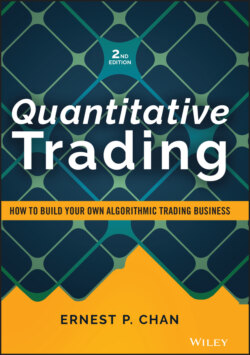Читать книгу Quantitative Trading - Ernest P. Chan - Страница 13
Scalability
ОглавлениеCompared to most small businesses (other than certain dot-coms), quantitative trading is very scalable (up to a point). It is easy to find yourselves trading millions of dollars in the comfort of your own home, as long as your strategy is consistently profitable. This is because scaling up often just means changing a number in your program. This number is called leverage. You do not need to negotiate with a banker or a venture capitalist to borrow more capital for your business. The brokerages stand ready and willing to do that. If you are a member of a proprietary trading firm (more on this later in Chapter 4 on setting up a business), you may even be able to obtain leverage far exceeding that allowed by Securities and Exchange Commission (SEC) Regulation T. It is not unheard of for a proprietary trading firm to let you trade a portfolio worth $2 million intraday even if you have only $50,000 equity in your account (a ×40 leverage). If you trade futures, options, or currencies, you can obtain leverage often exceeding ×10 from a regular brokerage, sparing yourself the trouble of joining a prop trading firm. (For example, at this writing, you only need about $12,000 in margin cash to trade one contract of the E-mini S&P 500 future, which has a notional market value of about $167,500.) At the same time, quantitative trading is definitely not a get-rich-quick scheme. You should hope to have steadily increasing profits, but most likely it won't be 200 percent a year, unlike starting a dot-com or a software firm. In fact, as I will explain in Chapter 6 on money and risk management, it is dangerous to overleverage in pursuit of overnight riches.
